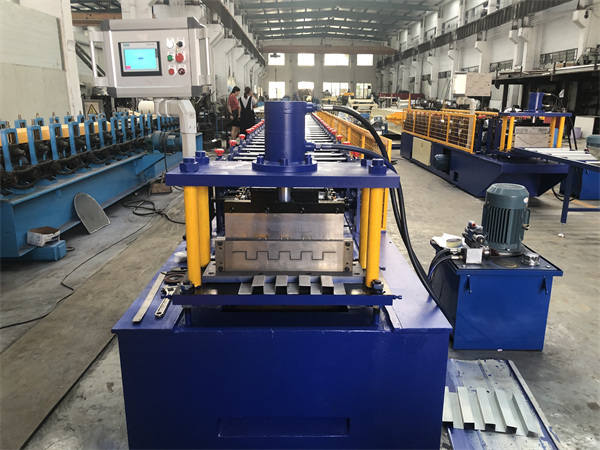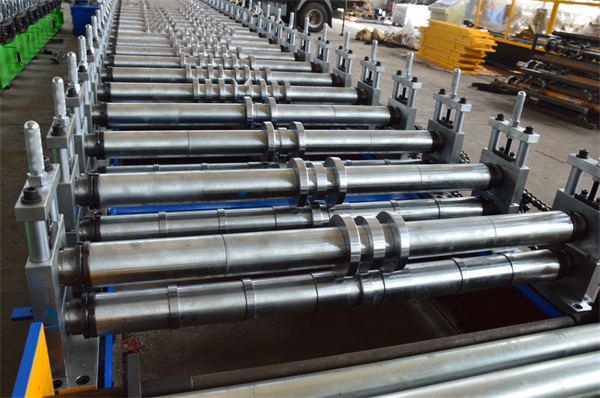r panel roll forming machines are an important type of metalworking equipment used to produce metal panels with ribbed or corrugated profiles. This article provides a comprehensive overview of r panel roll forming technology, manufacturing processes, machine specifications, and applications.
What are r panel roll forming machines?
r panel roll forming machines are designed to transform flat metal coils into shaped panels with repeating raised profiles. The name comes from the distinctive ribs or grooves formed along the length of the panel.
Key Features of R Panel Roll Forming Lines
- Produce metal panels with various ribbed, fluted, or corrugated profiles
- Use continuous feeding of coil strips and progressive bending
- Forming stations shape the profile with rollers
- Automated lines with high production speeds
- Flexibility to switch between different panel profiles
How r panel roll forming machines Work
R panel roll forming utilizes a series of consecutive stations with roller dies that gradually shape the flat strip into the desired ribbed profile. As the strip is fed through the machine, each station bends the metal incrementally until the final panel shape is achieved. The key steps include:
- Decoiling – The flat coil strip is loaded and fed into the roll former
- Feeding – The strip is pulled through by gripper chains/rolls at a constant speed
- Pre-punching – Holes for fasteners can be punched in advance
- Forming – Sequential rolling stations shape the profile in increments
- काट रहा है – Shears cut the formed panel to length
- Output – Formed panels are offloaded for storage or transport
Advanced roll forming lines are fully automated with servo motor drives, PLC controls, and touchscreen HMI to monitor line speed, production efficiency, and diagnostics.
R Panel Profiles and Materials
R panel roll forming lines can produce metal panels with different rib configurations, depths, and widths. The most common profiles include:
- Trapezoidal or inverted V ribs
- Sinusoidal or curved wave ribs
- Box or angular ribs
- Custom profiles
Typical Dimensions of R Panels
| प्रोफ़ाइल | Rib Height | Rib Spacing | Metal Thickness |
|---|---|---|---|
| Trapezoidal | 25-75 mm | 150-300 mm | 0.4-1.5 mm |
| Sinusoidal | 25-100 mm | 150-250 mm | 0.5-2 mm |
| Box/Angular | 15-50 mm | 100-250 mm | 0.5-1 mm |
These machines can form panels from coil stock of:
- Carbon steel – galvanized, pre-painted, weathering steel
- Aluminum – mill finish or painted
- Stainless steel – for high corrosion resistance
- Metal composites – zinc, titanium, coated steels

r panel roll forming machine Types
R panel production lines are available in different configurations and levels of automation to suit specific production needs.
Standard Roll Formers
- Entry-level simple machines
- Manual loading and offloading of coils
- 5-10 forming stations
- Production speed of 10-25 m/min
- Used for small to mid-size production runs
Automatic Cut-to-Length Lines
- Automatic decoiling and recoiling
- Servo motor driven forming stations
- Automatic shears to cut panels to length
- Higher speeds of 25-40 m/min
- Touchscreen controls and automated production
- For medium to large production volumes
High-Speed Roll Forming Lines
- Advanced fully automated lines
- Accelerated roll forming technology
- 20 or more progressive forming stations
- Ultra-high speeds of 60-100 m/min
- Integrated with automatic stacking
- Large scale continuous production
Technical Specifications
r panel roll forming machines are customized with features to meet specific production requirements. Technical specifications can include:
Line Speed
- 10-100 m/min or higher
- Speed determined by capability of each forming station
- Servo motors allow speed ramping for complex profiles
Forming Stations
- 5-25 or more stations
- Arrangement of top and bottom rolls
- Quick changeover forming dies
- Roller presses for tight radius bends
Drive System
- Servo, geared, or hydraulic motors
- Consistent speed control across line
द्रव्य का गाढ़ापन
- 0.3-2.0 mm
- Wider strips require heavier gates and rolls
सामग्री की चौड़ाई
- Up to 1300 mm possible
- 850-1000 mm typical
Coil Weight
- 1-5 metric tons standard
- Depends on decoiler capacity
Cut-to-Length
- Rotary or guillotine shears
- Length accuracy ±1.0 mm
- Programmable for different sizes
Power Supply
- 380-480V, 3 phase, 50/60 Hz
- 25-100 kW connected load
Production Speed
| Line Speed | Annual Volume* |
|---|---|
| 10 मीटर/मिनट | 350 tons |
| 25 m/min | 1,500 tons |
| 50 m/min | 5,000 tons |
| 100 m/min | 15,000 tons |
*Assuming single shift operation at 75% efficiency
Advanced lines also include features like:
- Touchscreen human-machine interface
- PLC and microprocessor controllers
- Servo motor drives with encoders
- Flying cut-off and stacking system
- Decoiler with loop control
- Automatic edge trimming
- Online non-contact quality inspection
- Data logging and diagnostics

R Panel Roll Forming Machine Applications
R panels produced on these roll forming lines are used in a wide range of construction, infrastructure, and industrial applications including:
Building and Construction
- Roofing
- Wall cladding
- Structural decking
- Architectural facades
- Partitioning
- Ceilings
- Silo and tank cladding
Infrastructure
- Large industrial buildings
- Warehouses
- Aircraft hangars
- Metro/train stations
- Religious spaces
- Shopping malls
- Cold storage facilities
Transportation
- Trailer side walls
- Truck bodies
- Bus roofs
- Railroad cars
- Marine containers
Industrial
- Grain silos
- Water tanks
- Equipment housings
- Machine guards
- Acoustic barriers
Ribbed metal panels offer benefits like strength, spanning ability, light weight, drainage, aesthetics, and quick installation compared to other building materials.
Applications by Metal Type
Galvanized Steel – Most common for roofing and cladding due to corrosion resistance. Pre-painted steel also available.
Aluminum – Lighter weight option for buildings, walls, cleanrooms, food processing.
Stainless Steel – Ultimate corrosion resistance for coastal areas, water tanks, chemical plans.
Weathering Steel – Ideal for outdoor structures with its protective rust patina.
Cost Analysis
आर पैनल रोल बनाने की मशीन prices vary based on the line configuration, level of automation, production speed, and features. Generally:
- Manual and semi-automatic lines cost $80,000 – $120,000
- Automatic cut-to-length lines from $150,000 to $350,000
- High-speed roll formers $500,000+
Other costs factors:
- Dies and Tooling – $2,000 to $4,000 per profile
- Site Preparation – Level floors, wiring, foundations
- Installation and Training – Typically included
Ongoing costs:
- Labor – 1-2 operators per shift
- Maintenance – 2% of machine cost annually
- Raw Materials – Coil stock, paint, etc.
- Utilities – Power consumption up to 100 kW
Payback Period
With estimated production costs of $0.20 to $0.40 per sq ft, most lines can achieve payback within 1-3 years. This depends on production efficiency and market prices.

Global r panel roll forming machine निर्माताओं
Some leading global suppliers of r panel production lines include:
| Company | Location |
|---|---|
| Shanghai Metal Corporation | China |
| Finn-Power | Finland |
| Metform | Turkey |
| Gasparini S.p.A. | इटली |
| Jouanel Industrie | फ्रांस |
| Eralp Makina | Turkey |
| Boisky | Korea |
| Anhui Modern Vocational Technology | China |
| Superprofil | Turkey |
| FABTECH | भारत |
These established manufacturers offer full installation and support services worldwide. Most supply panel lines customized for local standards and building codes.

Purchasing Considerations
Key factors to consider when investing in R panel roll forming equipment:
- उत्पादन मात्रा – Match machine capacity to your scale of production
- Panel Width – Determine the required strip width
- Profile and Thickness – Machine must be capable of forming your product designs
- Level of Automation – Evaluate labor costs vs automation costs
- रफ़्तार – Faster lines increase output but require heavier machines
- Quality Standards – Inspection systems may be needed for code compliance
- Training and Support – Look for suppliers willing to offer continued assistance
- Financing Options – Consider leasing or payment plans for affordability
Discuss your specific production goals with suppliers to select the right equipment for your needs.
सामान्य प्रश्न
Q: Are r panel machines suitable for small scale or starter production?
A: Basic manually operated lines can be a good affordable option for low to medium production volumes of around 100 tons annually. For very small startups, consider outsourcing roll forming to a tolling service instead.
Q: Can one machine make different rib profiles or do I need separate machines?
A: Some roll formers allow quick die changeovers to switch between profiles. But dedicated lines are more efficient for continuous high volume runs of the same profile.
Q: What thickness of metal sheet can these machines accommodate?
A: Most can form steel within 0.3 – 1.5 mm thickness. Heavier 2+ mm stock requires heavier duty and more powerful machines.
Q: How complex can the rib geometries be?
A: Around 15 degrees is the minimum bend radius for steel. More complex or curving profiles require advanced machines with special top and bottom rolls.
Q: How long does it take to install and commission a machine?
A: After site preparation, install and testing time ranges from 3-6 weeks typically. Manufacturers provide engineers to oversee the process.
Q: What factors affect the line speed and throughput?
A: Motor power, number of forming stations, tooling design, strip width and thickness all affect maximum speed. Automated lines allow faster speeds than manual operation.
Q: What regular maintenance is required?
A: Follow the manufacturer’s schedule for inspecting, lubricating, and replacing worn components like bearings, seals, and gears. Also periodically calibrate sensors, actuators, and controls.
Q: Are there safety standards or codes for these machines?
A: There are no universal global standards, but many countries require CE, UL, or other approvals. Your manufacturer can advise on certifications needed.
Q: How can I maximize the efficiency and uptime of a roll forming line?
A: Invest in high quality equipment, schedule preventive maintenance, train operators thoroughly, use automated features, and work closely with your manufacturer for support.
